
(a)
To write: the inequalities that represent the production time and deck finishing and quality control time.
(a)
Answer to Problem 7CYU
The inequalities are
Explanation of Solution
Given Information:
The total number of worker hours per day available for the production =
The total number of hours available for finishing decks and quality control =
The table for the skateboard manufacturing time is as follows.
| Skateboard manufacturing Time | ||
| Board Type | Production Time | Deck finishing/Quality Control Time |
| Pro Boards |
hours |
hours |
| Speciality Boards |
hour |
hours |
Let
Let
According to constraints production time, write the inequality as follows.
The constraint on total production time=
According to deck finishing and quality control time, write the inequality as follows.
The constrain on total deck finishing time =
Also the non-negative constraints are
(b)
To draw: the graph showing the feasible region.
(b)
Explanation of Solution
Given Information:
According to constraints , the inequality as follows.
The constraint on total production time is
The constraint on total deck finishing time is
Also the non-negative constraints are
Explanation for plotting the graph :
The graph of
To plot
The graph of
To plot
Plotting the Graph:
Plot the graph of the inequality
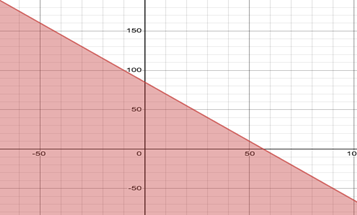
The graph of inequality
On the same graph plot the inequality
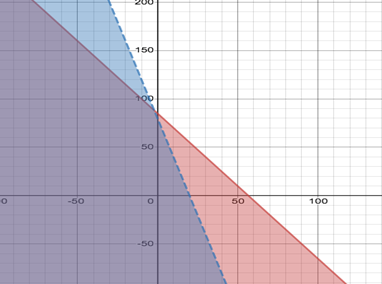
The graph of the inequality
Plot the non-negative constraints
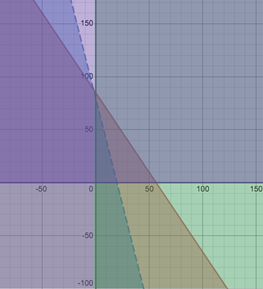
(c)
To list the coordinates of the vertices of the feasible region.
(c)
Answer to Problem 7CYU
The coordinates of the vertices of the feasible region are
Explanation of Solution
Given Information:
The feasible region is given as follows
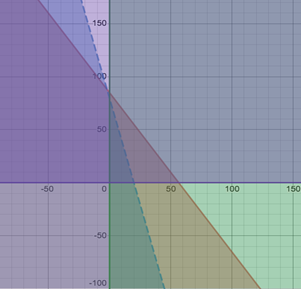
The graph of the feasible region
Mark the vertices of the feasible region and write its coordinates.
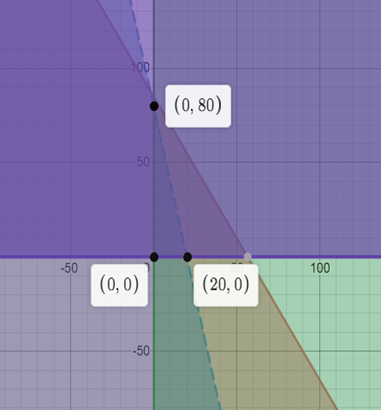
The graph showing the coordinates of the feasible region.
The coordinates of the vertices of the feasible region are
(d)
To write the function for the total profit on the skateboards.
(d)
Answer to Problem 7CYU
Function
Explanation of Solution
Given Information:
The profit on one pro board =
The profit on specialty board =
Let
Let
The profit on
The profit on speciality board =
Therefore, function
(e)
To determine the number of each type of skateboards that need to made to have maximum profit. Also find the maximum profit.
(e)
Answer to Problem 7CYU
The number of specialty skateboards =
The value of maximum profit =
Explanation of Solution
Given Information:
The profit function is given by
The coordinates of the vertices are
To maximise the profit function find the value at the vertices of the feasible region as follows.
| Vertices | Value of the profit function
|
|
|
|
|
|
|
|
|
|
The maximum value is
Result:
The number of specialty skateboards =
The value of maximum profit =
Chapter 3 Solutions
Glencoe Algebra 2 Student Edition C2014
Additional Math Textbook Solutions
University Calculus: Early Transcendentals (4th Edition)
Thinking Mathematically (6th Edition)
College Algebra with Modeling & Visualization (5th Edition)
Calculus: Early Transcendentals (2nd Edition)
Intro Stats, Books a la Carte Edition (5th Edition)
- A research study in the year 2009 found that there were 2760 coyotes in a given region. The coyote population declined at a rate of 5.8% each year. How many fewer coyotes were there in 2024 than in 2015? Explain in at least one sentence how you solved the problem. Show your work. Round your answer to the nearest whole number.arrow_forwardAnswer the following questions related to the following matrix A = 3 ³).arrow_forwardExplain the following termsarrow_forward
- Solve questions by Course Name (Ordinary Differential Equations II 2)arrow_forwardplease Solve questions by Course Name( Ordinary Differential Equations II 2)arrow_forwardInThe Northern Lights are bright flashes of colored light between 50 and 200 miles above Earth. Suppose a flash occurs 150 miles above Earth. What is the measure of arc BD, the portion of Earth from which the flash is visible? (Earth’s radius is approximately 4000 miles.)arrow_forward
- e). n! (n - 1)!arrow_forwardSuppose you flip a fair two-sided coin four times and record the result. a). List the sample space of this experiment. That is, list all possible outcomes that could occur when flipping a fair two-sided coin four total times. Assume the two sides of the coin are Heads (H) and Tails (T).arrow_forwarde). n! (n - 1)!arrow_forward
 Algebra and Trigonometry (6th Edition)AlgebraISBN:9780134463216Author:Robert F. BlitzerPublisher:PEARSON
Algebra and Trigonometry (6th Edition)AlgebraISBN:9780134463216Author:Robert F. BlitzerPublisher:PEARSON Contemporary Abstract AlgebraAlgebraISBN:9781305657960Author:Joseph GallianPublisher:Cengage Learning
Contemporary Abstract AlgebraAlgebraISBN:9781305657960Author:Joseph GallianPublisher:Cengage Learning Linear Algebra: A Modern IntroductionAlgebraISBN:9781285463247Author:David PoolePublisher:Cengage Learning
Linear Algebra: A Modern IntroductionAlgebraISBN:9781285463247Author:David PoolePublisher:Cengage Learning Algebra And Trigonometry (11th Edition)AlgebraISBN:9780135163078Author:Michael SullivanPublisher:PEARSON
Algebra And Trigonometry (11th Edition)AlgebraISBN:9780135163078Author:Michael SullivanPublisher:PEARSON Introduction to Linear Algebra, Fifth EditionAlgebraISBN:9780980232776Author:Gilbert StrangPublisher:Wellesley-Cambridge Press
Introduction to Linear Algebra, Fifth EditionAlgebraISBN:9780980232776Author:Gilbert StrangPublisher:Wellesley-Cambridge Press College Algebra (Collegiate Math)AlgebraISBN:9780077836344Author:Julie Miller, Donna GerkenPublisher:McGraw-Hill Education
College Algebra (Collegiate Math)AlgebraISBN:9780077836344Author:Julie Miller, Donna GerkenPublisher:McGraw-Hill Education





